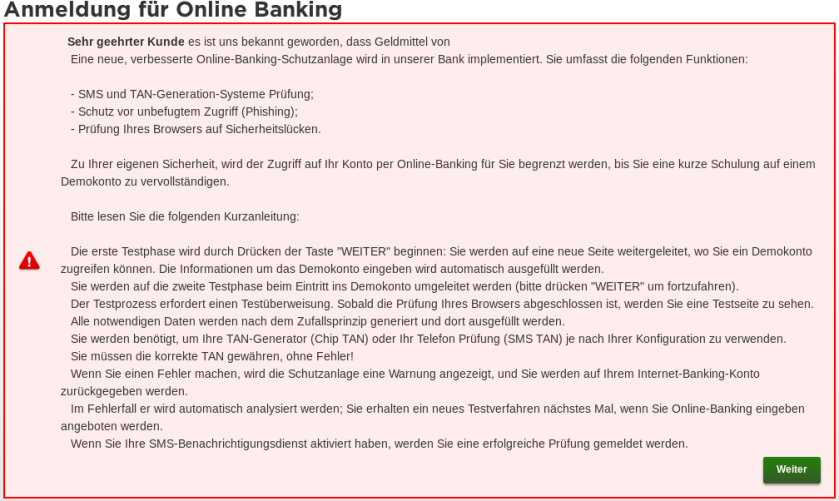Emotet is currently one of the prevalent threats on the Internet. The former banking trojan is now known to steal passwords and to drop other malware like Dridex on its infected machines. We recently found Emotet spreading Zeus Panda, which presented us with an opportunity to link some of our research on Emotet with our analysis of ZeuS Panda. The Zeus Panda sample used in this wave is rolled out through Emotet in german-speaking countries and targets online banking users in Germany and Austria.
The Emotet C2 server drops additional malware to infected system. Whether a system receives such a package seems to be based on the geographical location of the infected system in question. After the additional malware is downloaded from the C2 server, it is written to a file in %ALLUSERSPROFILE% (C:\ProgramData in recent Windows versions) with a random name of 4 to 19 characters length and the file extension “.exe”. Emotet is capable of executing this binary in two different ways, either of which is chosen by the C2 server. The first mode executes the malware in the same context that Emotet is running in, the second mode executes the malware in the context of the currently logged-on user.
As stated above, the current wave downloads and executes the well-known ZeuS Panda banking trojan. To know which banking sites it should attack and how to modify the site’s content, the trojan needs so-called webinjects. From the URL masks of the webinjects this sample uses, we can tell that it currently targets online banking customers in Germany and Austria. All injects write a single script reference into the targeted websites. When the targeted site is loaded, the browser loads the referenced script, which is then executed in the context of the banking website. The only difference between the webinjects is the last number in the URL of the script source. This number seems to define the targeted website, which allows the server to deliver a target-specific script. The script actually downloaded is obfuscated by a simple string encryption. The actual script is part of an Automated Transfer System (ATS) which tries to persuade the user into transferring money to an account the attacker specifies.


 The above screenshots show an exemplary representation on the modification of the banking websites. They show two different attack scenarios: The first script tries to trick the user into performing an transaction in the guise of a security check. The attackers “inform” the customer of newly installed security measures on the banking website, coercing the user to complete a training using a demo account, before they are able to access their account again. During this training, a real transaction is made in the background to an account that the attacker specifies. The phrasing in the text is lousy and should raise suspicion with most customers.
The above screenshots show an exemplary representation on the modification of the banking websites. They show two different attack scenarios: The first script tries to trick the user into performing an transaction in the guise of a security check. The attackers “inform” the customer of newly installed security measures on the banking website, coercing the user to complete a training using a demo account, before they are able to access their account again. During this training, a real transaction is made in the background to an account that the attacker specifies. The phrasing in the text is lousy and should raise suspicion with most customers.
The second script tries to persuade the user that an erroneous transfer was made to their account. It suggests to go to a bank branch or make the return transfer online. Additionally, the script blocks access to the banking account until the return transfer has been completed. The phrasing in the text is better than in the first script and may not raise suspicion at first glance.
The first script resembles word by word the webinject Kaspersky identified during their analysis of Emotet in 2015. At this time Emotet contained its own banking trojan capability and delivered the webinjects directly into the browser. As ZeuS Panda uses the same webinject format as the old Emotet, we can speculate about the reasons:
- The webinject is acquired from the same creator
- The group behind Emotet has dropped developing their own banking trojan and acquires such trojans from other malware authors
- The group behind Emotet developed multiple banking trojans for its own use and for sale
It seems Emotet is not only used to sell distribution of malware, but also used by its owners. It is also possible that the group behind Emotet uses the slim downloader as an entry point for targeted attacks. In this case the group can spread Emotet worldwide and distribute specific malware to each target. As the real malicious payload is only downloaded after some time and only to specific targets, analysts can not directly draw conclusions on the real intention of an infection.
C2:
5.9.195.154
45.73.17.164
60.32.214.242
85.25.33.71
194.88.246.242
213.192.1.170
217.13.106.16
217.13.106.246
217.13.106.249
SHA256:
0d25cde8d49e1bcf6a967c0df6ac76992ff129ea5c30a1492a5bedd313e6fb51
c287a9aa25ed6afc54bc5ebe4b098675f3fa4b7cb51fbdcfb50591b4b8fa3b90
ZeuS Panda:
C2:
uamanshe.gdn
ugjeptpyour.top
SHA256:
4fe20a9cf5e5c28ec55aa529179f7fe6df3cda8ae43340b04b2402f43dfefd5f
fbd9e31cc5cbfce2b8135234fdcfdac7fa48a127aa6f3644d05c6ba77bd6d903
